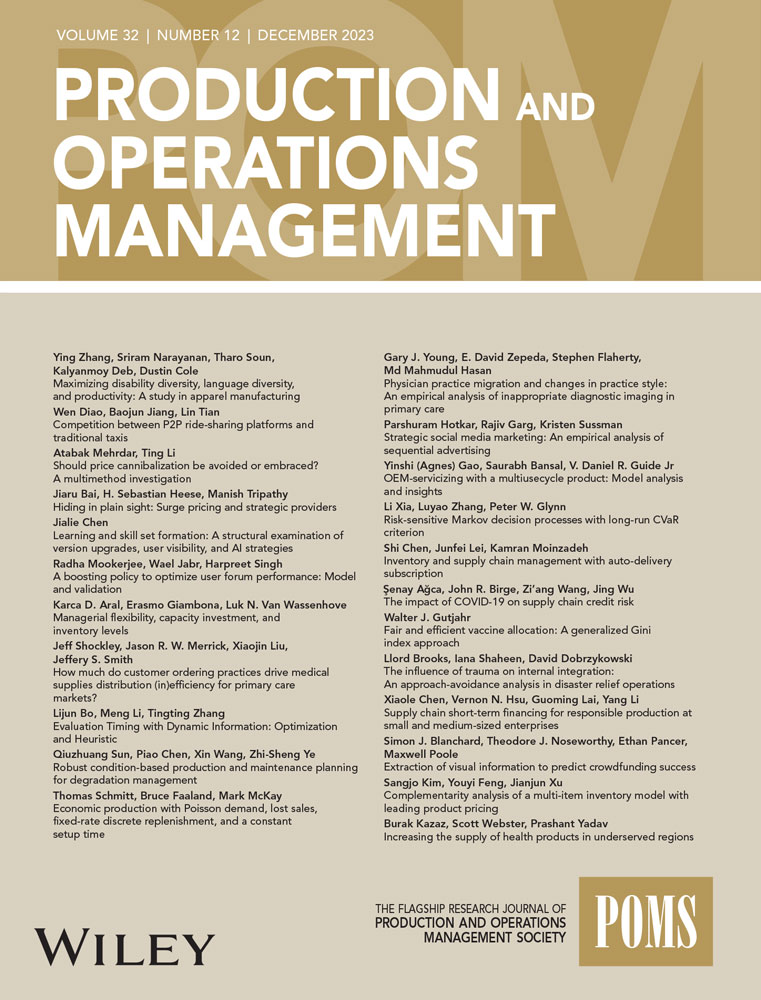COVID - 19对供应链信用风险的影响
IF 5.1
3区 管理学
Q1 ENGINEERING, MANUFACTURING
引用次数: 0
摘要
虽然全球供应链为企业提供了抵御局部冲击的缓冲,但也使企业面临多区域风险。COVID - 19大流行及其对世界不同地区的不同影响为探索这些影响提供了机会。我们通过关注信用违约互换(CDS)异常价差和中美供应链网络衡量的信用风险来研究多区域供应链风险。我们的证据表明,地方风险通过全球供应链传播到其他地区。通过匹配样本,我们发现,在中国经济停运期间,由于供应链中断,拥有中国供应链合作伙伴的公司的CDS异常息差相对于平均原始CDS息差增加了12%至13%,而当供应链活动在中国恢复时,CDS异常息差相对于平均原始CDS息差下降了9%至13%。我们还发现,拥有更全球化的客户基础可以减轻当地家庭需求冲击的影响。最后,我们发现企业规模、供应链网络中心性、现金持有量、库存、高信用评级、资本可再配置性和分部数量增加了应对全球供应链冲击的弹性,而财务杠杆、运营杠杆和市场竞争削弱了供应链的弹性。本文章由计算机程序翻译,如有差异,请以英文原文为准。
The impact of COVID‐19 on supply chain credit risk
Abstract While global supply chains provide firms with a buffer against local shocks, they expose firms to multiregional risks. The COVID‐19 pandemic and its differential impact on different regions in the world offer an opportunity to explore these effects. We investigate the multiregional supply chain risk by focusing on credit risk measured by abnormal credit default swaps (CDS) spreads and US–China supply chain networks. Our evidence shows that local risks propagate through global supply chains to other regions. Using a matched sample, we find that abnormal CDS spreads for firms with Chinese supply chain partners increase by 12% to 13% relative to the average raw CDS spreads due to supply chain disruptions during the economic shutdown in China, and the abnormal CDS spreads decrease by 9% to 13% relative to the average raw CDS spreads when the supply chain activities resume in China. We also find that having a more global customer base can mitigate the effects of local household demand shocks. Lastly, we discover that firm size, supply chain network centrality, cash holdings, inventory, strong credit ratings, capital redeployability, and the number of segments increase resilience to global supply chain shocks, while financial leverage, operational leverage, and market competition weaken supply chain resilience.
求助全文
通过发布文献求助,成功后即可免费获取论文全文。
去求助
来源期刊

Production and Operations Management
管理科学-工程:制造
CiteScore
7.50
自引率
16.00%
发文量
278
审稿时长
24 months
期刊介绍:
The mission of Production and Operations Management is to serve as the flagship research journal in operations management in manufacturing and services. The journal publishes scientific research into the problems, interest, and concerns of managers who manage product and process design, operations, and supply chains. It covers all topics in product and process design, operations, and supply chain management and welcomes papers using any research paradigm.
 求助内容:
求助内容: 应助结果提醒方式:
应助结果提醒方式:


